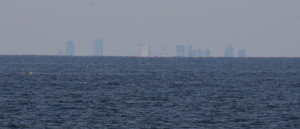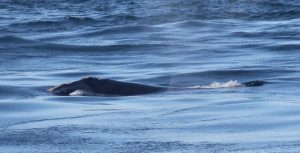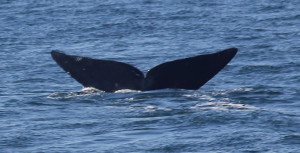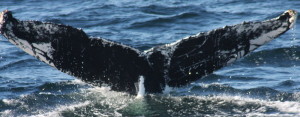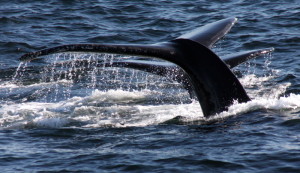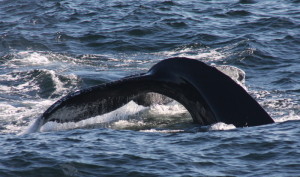October 17 to October 22
After less than stellar conditions the previous week, we were excited to get back on the water on October 17 to find that the weather had changed considerably for the better. Though it was chilly with a light swell, our visibility was nearly unlimited — so good in fact that from the Northwest corner of Stellwagen Bank we could see all the way to the Boston skyline.
We ended up there after some serious searching on the morning trip. We first headed East, toward Peaked Hill, then up onto Stellwagen. Good visibility meant that got a lot of great views of Minke whales throughout our travels.
We finally found humpback whales, including Jupiter and another unknown, on the southwest corner of Stellwagen as we past through on our way home. Jupiter was embarking on some long dives, but we stuck around long enough to get a few good looks.
On the mid-day trip, we had a very exciting sighting not too far along into the day. As we approached Race Point, we started seeing a spout right off the beach. As we got closer, we noticed that the spout had a distinct V shape, and we quickly realized that we were looking at a North Atlantic right whale!
Right whales are very endangered animals — the current population estimate is at about 500 individuals. Because of their endangered status and because they are very prone to ship-strikes, we abide by federal law to maintain a 500 yard distance between the vessel and the animal. Cape Cod Bay is a critical habitat for these whales and in the spring, we often see over half of the population visit these waters to feed on their nearly microscopic prey, the calanoid copepod as these planktonic animals feast on the spring phytoplankton bloom. If oceanic conditions permit, there is sometimes a secondary, less intense fall bloom that brings right whales back to our waters in the fall. In general sightings are much more scarce, but it is not particularly unusual to see these rare creatures stopping by Race Point in the fall to see if there is anything worth eating.
October 18 involved another long search for whales. We finally ended up in the Northeast corner of Stellwagen Bank again, nearly 20 miles away from Provincetown! Fortunately, there was a lot to see. We passed many Minke whales on our way out, and were even able to spot a few fin whales spouting to the south. We had much better luck at finding humpbacks today, and we counted at least six of them on our afternoon trip. This included Banyon, Sundown, Sprinkler and Cantilever.
We even had a humpback mother and calf pair, Palette and her calf, approach the boat! Another striking moment of the trip was the small pod of harbor porpoise that rose to the surface nearby, staying at the surface for a few minutes and then disappearing again. Of all the cetaceans that we see on our trips, porpoise probably keep the lowest profile, and we were excited to get even a quick look at, by our count, between fifteen and thirty of them!
The winds were brisk on October 19, but it turned out to be a great day for Minke whales. We documented a total of ten individuals, all solitary animals, with most sightings occurring between Wood End and Herring Cove, relatively early on in the trip. Once we rounded Race Point and headed towards Peaked Hill, we had a few more Minkes as well as a good look at a single humpback.
What was truly spectacular today was the bird life. All around us, mature Northern gannets, the largest seabird in the area, were plunge diving. This involves these birds tucking their wings against their body and dropping from the sky, plunging head first into the water and emerging seconds later with a mouthful of fish. These birds make such a splash that we sometimes mistake their dives for whale spouts! Today, we estimated that there must have been almost 1,000 of them between Wood End and Race Point.
Gannet excitement continued into October 20th where we estimated over 500 birds at Race Point. Race Point is the northern tip of the Cape and represents the area where Cape Cod bay collides with the rest of the Gulf of Maine, these confluence of waters bodies create currents, upwellings, and racing tides which are often the perfect set of conditions for feeding animals. Nutrients get pushed to the surface, plankton gets aggregated, and larger predators flock here to feed.
Gannets weren’t the only ones taking advantage of the bounty near Race Point. Minke whales were ubiquitous, and soon we even spotted a pod of Common dolphins. These distinctively-pigmented animals have hour-glass shaped markings along their bodies, which were highly visible today as they porpoised and surfed on the mounting swell.
On the morning of October 21st, the true highlight of the trip was the great looks at Minke whales. This morning, we saw 8-10 of these small baleen whales, with some of them even approaching the boat! Though Minkes are ubiquitous in our waters, they are not a well-studied species, and we don’t know nearly as much about them as we do of our constantly photographed humpbacks. Minke whales can grow to be over 30 feet long, but most of the Minkes that we see in this area are smaller juveniles.
In the afternoon we were able to locate two humpbacks, Glyph and Storm. These whales were traveling separately, occasionally raising their tails for the picture perfect fluke shot!
By October 22nd we were really starting to feel fall creep in. Although there are still whales around, we are observing fewer and fewer humpbacks as they prepare for their southward migration to their winter breeding grounds. There are still a few mother and calf pairs hanging around, and today we had a chance to get good looks at Palette and her calf. Palette was born in 1989 and this is her seventh calf.
At first we were catching nothing but quick glimpses, but eventually we noticed that the two would occasionally parallel the Dolphin IX’s course, allowing us some very good looks at these animals. We also had a chance to see a small pod of Atlantic white-sided dolphins. These animals tend to travel in groups, but the group today we saw was small, consisting of only five to ten members.
While the season is winding down, there are still lots of animals visiting our area to feed on fish, squid, plankton, jellies and more!






